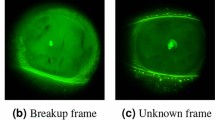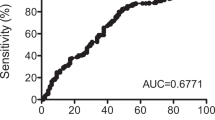Abstract
Dry eye disease (DED) is a chronic eye disease and a common complication among the world's population. Evaporation of moisture from tear film or a decrease in tear production leads to an unstable tear film which causes DED. The tear film breakup time (TBUT) test is a common clinical test used to diagnose DED. In this test, DED is diagnosed by measuring the time at which the first breakup pattern appears on the tear film. TBUT test is subjective, labour-intensive and time-consuming. These weaknesses make a computer-aided diagnosis of DED highly desirable. The existing computer-aided DED detection techniques use expensive instruments for image acquisition which may not be available in all eye clinics. Moreover, among these techniques, TBUT-based DED detection techniques are limited to finding only tear film breakup area/time and do not identify the severity of DED, which can essentially be helpful to ophthalmologists in prescribing the right treatment. Additionally, a few challenges in developing a DED detection approach are less illuminated video, constant blinking of eyes in the videos, blurred video, and lack of public datasets. This paper presents a novel TBUT-based DED detection approach that detects the presence/absence of DED from TBUT video. In addition, the proposed approach accurately identifies the severity level of DED and further categorizes it as normal, moderate or severe based on the TBUT. The proposed approach exhibits high performance in classifying TBUT frames, detecting DED, and severity grading of TBUT video with an accuracy of 83%. Also, the correlation computed between the proposed approach and the Ophthalmologist's opinion is 90%, which reflects the noteworthy contribution of our proposed approach.














Similar content being viewed by others
Explore related subjects
Discover the latest articles, news and stories from top researchers in related subjects.References
Sanchez-Tena MAMA, Alvarez-Peregrina CC, Villa-Collar CC (2019) Dry eye analysis: a citation network study. J Ophthalmol 2019:1–9
Galor A (2019) Painful dry eye symptoms: a nerve problem or a tear problem? Ophthalmology 126(5):648–651
Lemp MA, Foulks GN (2019) Dry eye disease: a modern history. In: Foundations of corneal disease, Springer, Cham pp 23–30
Bazeer S, Jansonius N, Snieder H, Hammond C, Vehof J (2019) The relationship between occupation and dry eye. Ocul Surf 17(3):484–490
Lin H, Yiu S (2014) Dry eye disease: a review of diagnostic approaches and treatments. Saudi J Ophthalmol 28(3):173–181
Latkany R, Miller D, Zeev M (2014) Diagnosis of dry eye disease and emerging technologies. Clin Ophthalmol (Auckland, NZ) 8:581
Ozcura F, Aydin S, Helvaci M (2007) Ocular surface disease index for the diagnosis of dry eye syndrome. Ocul Immunol Inflamm 15(5):389–393
Gayton J (2009) Etiology, prevalence, and treatment of dry eye disease. Clin Ophthalmol 3:405–412
Tsubota K (2017) New perspectives on dry eye definition and diagnosis: a consensus report by the Asia dry eye society. Ocul Surf 15(1):65–76
Vanley G, Leopold I, Gregg T (1977) Interpretation of tear film breakup. Arch Ophthalmol 95(3):445–448
Bron A, Abelson M, Ousler G, Pearce E, Tomlinson A, Yokoi N (2007) Methodologies to diagnose and monitor dry eye disease: report of the diagnostic methodology subcommittee of the international dry eye workshop (2007). Ocul Surf 5(20):108–152
Bron A, Smith J (2003) Grading of corneal and conjunctival staining in the context of other dry eye tests. Cornea 22(7):640–650
Wang MTM, Diprose WK, Craig JP (2020) Epidemiologic research in dry eye disease and the utility of mobile health technology. Jama Opthalmol 138: 69–70; Han SB, Liu Y-C, Mohamed-Noriega K, Tong L, Mehta JS (2020) Objective imaging diagnostics for dry eye disease. J Opthalmol Hindawi, ID 3509064, pp 1–11 (2020)
Mc-monnies questionnaire. https://www.tearfilm.org/dewsreport/pdfs/Questionnaire%20McMonnies%20questionnaire%20(Caffery).pdf. Accessed on: 10 Nov 2018
Ocular Surface Disease Index. http://www.supereyecare.com/resources/OSDI.pdf. Accessed on: 10 Nov 2018
Dry eye questionnaire. https://www.tearfilm.org/dewsreport_Italian/pdfs/Questionnaire%20DEQ%20questionnaire%20(Caffery).pdf. Accessed on: 10 Nov, 2018
Titiyal J, Falera R, Kaur M, Sharma V, Sharma N (2018) Prevalence and risk factors of eye disease in North India: ocular surface index-based cross sectional hospital study. Indian J Ophthalmol 66(2):207–211
Galveia J, Travassos A, Quadros F, Cruz L (2017) Computer-aided diagnosis in ophthalmology: deep learning applications. Lecture notes in computational vision and biomechanics classification in BioApps, pp 263–293
Vicnesh J, Oh SL, Wei JKE, Ciaccio EJ, Chua KC, Tong L, Acharya UR (2020) Thoughts concerning the application of thermogram images for automated diagnosis of dry eye—a review. Infrared Phys Technol 106:103271
Vyas AH, Mehta MA (2020) A comprehensive survey on image modality based computerized dry eye disease detection techniques. Adv Sci Technol Eng Syst J 5(2):748–756
Takenori I, Jaemyoung S, Masahiro N, Masao I, Yuichi O, Nanami I, Inomata M, Akie RN, Keiichi F, Atsuko E, Ke N, Kenta F, Maria M, Hurramhon S, Akira M (2020) Using medical big data to develop personalized medicine for dry eye disease. J Cornea External Disease 39:39–46
Su T, Liu Z, Chen D (2018) Tear film break-up time measurement using deep convolutional neural networks for screening dry eye disease. IEEE Sens J 2018:1–1
Su T, Liu Z, Chen D (2020) Tear film breakup time measurement for screening dry eye disease by deep convolutional neural network. U.S. Patent 10779725B2, issued September 2020
Yedidya T, Hartley R, Guillon J, Kanagasingam Y (2007) Automatic dry eye—detection. Medical image computing and computer-assisted intervention—MICCAI 2007 Lecture Notes in Computer Science, pp 792–799
Yedidya T, Hartley R, Guillon J-P (2008) Automatic detection of pre-ocular tear film break-up sequence in dry eyes. In: 2008 Digital Image computing: techniques and applications
Ramos L, Barreira N, Verdeal H, Giráldez M, Pimentel E (2015) Computational approach for tear film assessment based on breakup dynamics. Biosys Eng 138:90–103
Ramos L, Barreira N, Mosquera A, Verdeal H, Yebra-Pimentel E (2013) Break-up analysis of the tear film based on time, location, size and shape of the rupture area. Lecture notes in computer science image analysis and recognition, pp 695–702
Ramos L, Barreira N, Mosquera A, Currás M, Verdeal H, Giráldez M, Penedo M (2013) Computational approach for measuring the tear film break-up time in an unsupervised manner. In: Advanced techniques for knowledge engineering and innovative applications communications in computer and information science, pp 254–267
Cebreiro A, Ramos L, Barreira A, Noelia, Manuel FP (2011) Automation of the tear film breakup time test. In: ACM international conference proceeding series
Remeseiro B, Barreira N, Sánchez-Brea L, Ramos L, Mosquera A (2017) machine learning applied to optometry data. In: Advances in biomedical informatics intelligent systems reference library, pp 123–160
Remeseiro B, Barreira N, Resua C, Lira M, Giraldez M, Pimentel E, Penedo M (2016) iDEAS: a web-based system for dry eye assessment. Comput Methods Prog Biomed 130:186–197
Remeseiro B, Mosquera A, Penedo M (2016) CASDES: a computer-aided system to support dry eye diagnosis based on tear film maps. IEEE J Biomed Health Inform 20(3):936–943
Acharya U, Tan J, Koh J, Sudarshan V, Yeo S, Too C, Chua C, Ng E, Tong L (2015) Automated diagnosis of dry eye using infrared thermography images. Infrared Phys Technol 71:263–271
Aihara E, Torii I, Ishii N (2016) Development of monitor system for dry eye symptom. In: 2016 4th international conference on applied computing and information technology/3rd international conference on computational science/intelligence and applied informatics/1st international conference on big data, cloud computing, data science and engineering (ACIT-CSII-BCD)
Bartuzel M, Iskander DS, Iskander DH (2014) Automatic dynamic tear meniscus measurement in optical coherence tomography. Biomed Opt Express 5(8):2759–2768
Zeiler M, Fergus R (2014) Visualizing and understanding convolutional networks. In: Computer vision—ECCV 2014 lecture notes in computer science, pp 818–833
Karpathy A, Toderici G, Shetty S, Leung T, Sukthankar R, Fei-Fei L (2014) Large-scale video classification with convolutional neural networks. In: 2014 IEEE conference on computer vision and pattern recognition
Hagerty J, Stanley RJ, Stoecker W (2017) Medical image processing in the age of deep learning—is there still room for conventional medical image processing techniques? In: Proceedings of the 12th international joint conference on computer vision, imaging and computer graphics theory and applications
Krizhevsky A, Sutskever I, Hinton GE (2017) ImageNet classification with deep convolutional neural networks. Commun ACM 60(6):84–90
Simonyan K, Zisserman A (2014) Very deep convolutional networks for large-scale image recognition. CORR, 1409.1556
Szegedy C, Liu W, Jia Y, Sermanet P, Reed S, Anguelov D, Erhan D, Vanhoucke V, Rabinovich A (2015) Going deeper with convolutions. In: 2015 IEEE conference on computer vision and pattern recognition (CVPR)
He K, Zhang X, Ren S, Sun J (2016) Deep residual learning for image recognition. In: 2016 IEEE conference on computer vision and pattern recognition (CVPR), pp 770–778
Tajbakhsh N, Shin J, Gurudu S, Hurst R, Kendall C, Gotway M, Liang J (2016) Convolutional neural networks for medical image analysis: full training or fine tuning? IEEE Trans Med Imaging 35(5):1299–1312
Shin H, Roth H, Gao M, Lu L, Xu Z, Nogues I, Yao J, Mollura D, Summers R (2016) Deep convolutional neural networks for computer-aided detection: CNN architectures, dataset characteristics, and transfer learning. IEEE Trans Med Imaging 35(5):1285–1298
Storås AM, Strümke I, Riegler MA, Grauslund J, Hammer HL, Yazidi A, Jackson CJ (2022) Artificial intelligence in dry eye disease. Ocul Surf 23:74–86
Xie X, Niu J, Liu X, Chen Z, Tang S, Yu S (2021) A survey on incorporating domain knowledge into deep learning for medical image analysis. Med Image Anal 69:101985
Schmidl D, Schlatter A, Chua J, Tan B, Garhöfer G, Schmetterer L (2020) Novel approaches for imaging-based diagnosis of ocular surface disease. Diagnostics 10(8):589
Shimizu E, Yazu H, Aketa N, Yokoiwa R, Sato S, Katayama T, Hanyuda A, Sato Y, Ogawa Y, Tsubota K (2021) Smart eye camera: a validation study for evaluating the tear film breakup time in human subjects. Transl Vis Sci Technol 10(4):28
Yazdani M, Fiskådal J, Chen X, Utheim ØA, Ræder S, Vitelli V, Utheim TP (2021) Tear film breakup time and dry eye disease severity in a large Norwegian cohort. J Clin Med 10(4):884
Bilkhu P, Sivardeen Z, Chen C, Craig JP, Mann K, Wang MTM, Jivraj S, Mohamed-Noriega K, Charles-Cantú DE, Wolffsohn JS (2022) Patient-reported experience of dry eye management: an international multicentre survey. Cont Lens Anterior Eye 45(1):101450
Gadekallu TR, Khare N, Bhattacharya S, Singh S, Maddikunta PKR, Ra IH, Alazab M (2020) Early detection of diabetic retinopathy using PCA-firefly based deep learning model. Electronics 9(2):274
Gadekallu TR, Khare N, Bhattacharya S, Singh S, Maddikunta PKR, Srivastava G (2020) Deep neural networks to predict diabetic retinopathy. J Ambient Intell Human Comput 1–14
Reddy GT, Bhattacharya S, Ramakrishnan SS, Chowdhary CL, Hakak S, Kaluri R, Reddy MPK (2020) An ensemble based machine learning model for diabetic retinopathy classification. In: 2020 international conference on emerging trends in information technology and engineering (ic-ETITE). IEEE, pp 1–6
Acknowledgements
The authors would sincerely like to thank Dr. Ravish Kinkhabwala (M.D. OPHTH, AIIMS, New Delhi) from Vaikunth Eye Clinic, Ahmedabad, Gujarat, India, for providing valuable information and knowledge on the dry eye disease and related concepts along with the TBUT video dataset. We are also thankful to him for helping in the process of video frame annotation and for preparing ground truths for our research.
Author information
Authors and Affiliations
Corresponding authors
Ethics declarations
Conflict of interest
The authors declare that they have no conflict of interest.
Additional information
Publisher's Note
Springer Nature remains neutral with regard to jurisdictional claims in published maps and institutional affiliations.
Rights and permissions
Springer Nature or its licensor holds exclusive rights to this article under a publishing agreement with the author(s) or other rightsholder(s); author self-archiving of the accepted manuscript version of this article is solely governed by the terms of such publishing agreement and applicable law.
About this article
Cite this article
Vyas, A.H., Mehta, M.A., Kotecha, K. et al. Tear film breakup time-based dry eye disease detection using convolutional neural network. Neural Comput & Applic 36, 143–161 (2024). https://doi.org/10.1007/s00521-022-07652-0
Received:
Accepted:
Published:
Issue Date:
DOI: https://doi.org/10.1007/s00521-022-07652-0




